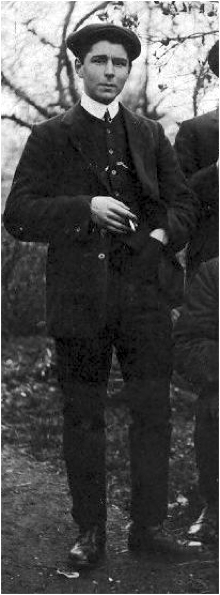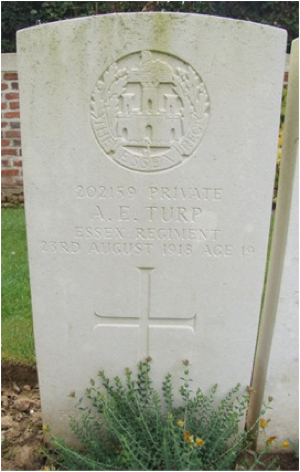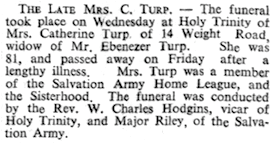Arthur Edward Turp came to Springfield as a toddler, the son of an agricultural worker. He served in the army during the war and was killed in action in August 1918 during the Battle of Amiens. His home was in Wharf Road.
TURP, ARTHUR EDWARD,
Private (Signaller), 1st Battalion, Essex Regiment

Arthur was born in Great Leighs in 1898, the son of Ebenezer John (sometimes ‘John’) Turp and Catherine Turp (nee Milbank). His father had been born c1851 at Pentlow; his mother in 1856 in Roxwell. They had married in 1872. In 1881 the family had been living at Great Leighs, and in 1891 at Camper’s Cottage in Great Leighs.
Arthur’s twelve siblings included Charlotte Maria Turp (born in County Durham in 1874, died in 1877), Harriett Julia Turp (born in 1876 in County Durham), Alfred Albert Turp (born in 1878 in Little Leighs, died in 1959), Lucy Jane Turp (born in 1881 in Great Leighs), Florence Emma Turp (born in 1883 in Great Leighs, died in 1968), William John Turp (born in 1886 in Great Leighs, died in 1951), Catherine Ethel Turp (born in 1889 in Great Leighs, died in 1960), Mary Alice Turp (born in 1891 in Great Leighs, died in 1974),Dorothy Lily Turp (born in 1894) and Edith Ellen Turp (born in 1892 in Great Leighs).
Three of the twelve died by 1911, including Arthur’s sister Charlotte who was killed, aged two, when run over by a runaway horse and cart at Little Waltham in 1877.
The 1901 census found two year-old Arthur living with his parents and four siblings at Graces in Springfield Street, Springfield (now Springfield Road). His father was a milkman on a farm.
Six years later Arthur’s paternal grandfather died in Springfield at the grand old age of 103.
The 1911 census recorded 12 year-old Arthur living with his parents, sister, niece and two boarders at 2 Canal Cottages, The Wharf in Springfield. Arthur’s father was a cow man.
Arthur lived in Springfield, enlisted at Chelmsford and served as Private 202159 in the 1st Battalion of the Essex Regiment. For most of the war it formed part of the 88th Brigade in the 29th Division and fought at Gallipoli, the Somme, Monchy-le-Preux and Cambrai. On 4th February 1918 the battalion was transferred to the 112th Brigade in the 37th Division.
In August 1918 Arthur’s battalion was around ten miles south of Arras in France, where it was poised to participate in the British offensive later known as the Battle of Bapaume, the second phase of the Battles of Amiens. The
offensive began on 21st August 1918, though the 1st Battalion of the Essex Regiment was not heavily involved in the initial day’s action, having been in reserve. However, on the 22nd the battalion marched to assembly positions north of Achiet-le-Petit, with two companies in the front line and two in support ready for its advance which began the following day - part of an attack along a 33 mile front. A post-war history of the battalion reported:
“Orders to attack came at short notice to the 112th Brigade. At 4 a.m. on the 23rd the 3rd Division captured Gomiecourt, which had an important influence on the operations in this quarter. Its commander agreed to co-operate with the 37th Division in a further forward movement, the immediate objective of the latter being the village of Achiet-le-Grand, which the enemy held in some strength.
On the right the 5th Division were advancing on Irles. Not only was the ground rendered difficult by the cutting of the Arras-Amiens railway - which was in places 35 feet deep - and the track running from the last-named village to Bapaume, but the enemy had planted machine guns along it on the average of one to every twenty yards. There were also numerous banks and trenches which served as cover. A large brickworks in front of the railway and opposite Achiet-le-Grand was strongly held, as was also a spur to the south, which was later to prove very troublesome to the Essex.
The 112th Infantry Brigade operated in a south-easterly direction from Achiet-le-Petit, having experienced some difficulty in forming up north of the village owing to the disorganised state of some units of another division which had recently attacked, and to the lack of reconnaissance. Touch with the 5th Division had not been established at zero hour.
111th Brigade were on the left with Achiet-le-Grand as the objective. To 13th Royal Fusiliers was allotted the capture of the railway cutting and the road beyond south of Achiet-le-Grand, the 1st Herts. to pass through and press the advantage. The Essex, on the right, had also to capture a section of the railway cutting and roads beyond, but the greater pressure was applied on the left, where Bihucourt lay upon the Bapaume road, and the enemy were in movement owing to the break-through at Gomiecourt. Moreover, until the 5th Division had taken Irles the advance could not be urged too far on the right. The battalions had each the use of one section of the Machine Gun Company.
At 11 a.m., on one of the hottest days of the year, the barrage came down 200 yards east of the outpost line, and at 11.08 a.m. the Fusiliers and Essex moved forward. The former battalion immediately met with strong opposition from the brickworks on the left flank and a trench nearby, but the resistance was overcome by an outflanking operation, in conjunction with Stokes and Lewis gun fire. Over sixty of the enemy surrendered with eleven light machine guns. The advance was quickly resumed and caught up with the bararge. Moving on, the Fusiliers gained a footing on the railway, despite heavy machine gun and rifle fire, and pushed a Lewis gun team across the metals in time to fire into the backs of the enemy to the south.
Hertfordshires lost three of their company commanders early in the action, but instead of jumping through the Fusiliers they went further to the south, also gaining the cutting and taking many prisoners and machine guns. The railway securely in our hands, the Fusiliers moved to their final objective, and Hertfordshires, in line with them, also progressed and captured a battery of artillery. As touch, however, could not be found with troops either side, and the enemy were observed working round the right flank, the line was withdrawn until contact could be regained, and then the troops advanced.
At 5.30 p.m. another forward move was made, but only 200 yards could be gained on the left flank, as a large number of enemy machine guns were still within the artillery barrage. 111th Brigade on the left also made good progress and occupied the trench running from the Bapaume railway to Bihucourt, having cleared Achiet-le-Grand.
Let us now turn and follow the fortune of the Essex men on the right. Their attack was made in four waves; two companies in the front line and two in the support line, in the following order:
Y W Z X

When the artillery opened at 11 a.m. the companies moved forward as close to the barrage line as possible, and thus escaped the enemy’s shelling, which immediately descended on to the trenches vacated by them. The offensive was steady and uninterrupted until the right flank neared the spur of the ridge, south of the brickworks, when it came under heavy fire from the railway and the hedge on the eastern side of the trench. The left flank pushed on and reached the summit of the ridge before coming under fire, and some of the men, with great gallantry, penetrated the wire of the trench guarding the railway though the Battalion suffered severely from machine guns at this point, the ridge behind the railway and from a derelict tank.
No further progress was possible until the 5th Division worked forward, as the right flank was in the air. Meanwhile the supporting companies pushed into the firing line and units became mixed. A party of about 20 men, under 2nd Lieut. E. P. Bugg, rushed forward, but failed to gain ground, the officer and the majority of the party being killed or wounded. Captain Mathieson asked for the assistance of a tank, and about 1.37 p.m. one came on the scene from the left flank and opened fore upon the the trench. Taking advantage of the decreased hostile activity Captain Mathieson seized
the trench, and whilst he and 2nd Lieut, Butler organized the right flank, 2nd Lieut. Silver directed the left flank, another party under 2nd Lieut. Moss also entering the contested position. Losing no time, the Battalion pushed on to the railway line and were in possession by 2 p.m.
Touch with flanks was instantly sought. 2nd Lieut, Silver reconnoitred a line of trenches parallel with the Bapaume railway but could find no sign of British troops on the left. Capt. Mathieson searched the sunken road in front up to the cross roads linking Achiet-le-Grand with Irles for signs of the enemy, but found none, except for four field guns which had been lately abandoned. Touch had been regained on the right, however, with the 1st Bedfordshires, of the 5th Division. Three companies of the Essex occupied the trench guarding the cross roads, whilst the fourth company garrisoned the railway crossing leading to Achiet-le-Petit. A series of posts was established at the cross roads - one on the right flank, one on the left and three in rear. Throughout the afternoon reports were received that enemy reinforcements were being brought up in motor lorries from the direction of Loupart Wood, Grévillers and Biefvillers.
Another forward movement was made at 5.45 p.m., but on the troops reaching the ridge in front of Grévillers heavy machine gun fire was experienced on the left, and the men were withdrawn, though not before the enemy were observed to be retiring and fire opened upon them. The Divisional Commander wrote of this advance of the Essex as ‘most gallant’, but the troops on the left could not get forward owing to strong pockets of enemy holding the copse, portion of railway line and trench south-west of Bihucourt. At 7.30 p.m. the 5th Division came into line on the right and touch was established with the left, the captured ground being consolidated.
It was in respect of this action that the G.O.C., 5th Division, reported: ‘The left of the attack was completely held up for a time, and it was not until two tanks working in front of the 37th Division had nearly gained the crest and put out many enemy machine guns that the advance could be resumed. These tanks, and the magnificent advance of the 37th Division, which had only relieved the 63rd Division during the previous night, on our left, undoubtedly allowed the 1st Bedfords to gain their final objective.’ This was praise, indeed, and all the more gratifying inasmuch as the Essex were on the left of the Bedfords, and it was their movement which was doubtless principally in mind when the appreciation was penned.
Before night came the 10th Royal Fusiliers of the 111th Brigade lay easy of Bihucourt, threatening Biefvillers, with 13th K.R.R. and 13th Rifle Brigade between Achiet--le-Grand and Bihucourt, the 112th Brigade being upon a line slightly in the rear from Achiet-le-Grand southward.”
By the time Arthur’s battalion was withdrawn from action after five days it had suffered four officers and 78 other ranks killed, ten officers and 197 others wounded and eight missing. The dead included Arthur who was killed in action by a shell on 23rd August 1918. Today he lies at Bucquoy Communal Cemetery Extension (grave: A. 5). The cemetery contains 68 First World War burials, all dating from 23rd to 28th August 1918.
Bapaume was subsequently captured by the British on 29th August 1918.
News of Arthur’s death appeared in the Essex Weekly News on 6th September 1918, which recorded his rank as ‘sergeant’:
“Sergt. A Turp, Essex Regt., son of Mr. E. Turp, Navigation-cottages, Chelmsford, has been killed. He was 20 years of age, and had been four years in the Army. In a letters to deceased’s sister his officer informed her that her brother was employed on battalion signals, and had just completed some good work with two others when a shell caught them and instantly killed him and wounded the other two men. He was buried in the military cemetery alongside many of is comrades who fell on the same day. The officer added: ‘I deeply regret his loss, as he was a good worker and a bight lad who showed good prospects.”
A week later the Essex County Chronicle reported:
“Sgt. A Turp, Essex Regt., son of Mr. E. Turp, Navigation Cottages, Chelmsford, has been killed. He was 20, and had been four years in the Army. He had just completed some good work on battalion signals when a shell instantly killed him.”
Arthur is commemorated on the Civic Centre Memorial, Chelmsford and on the Springfield Parish Memorial at All Saints’ Church. He was entitled to the Victory and British War medals.
The 1918 register of electors listed Arthur’s parents still at 2 Canal Cottages, The Wharf, Springfield. His father died on 30th April 1926 aged 75 and his mother died on 29th October 1937 aged 81.
140123
